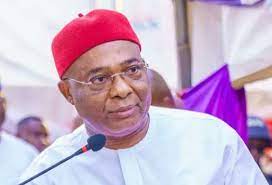An anticipated landslide victory for Governor Hope Uzodimma of the All Progressives Congress (APC) at the Saturday, November 11 governorship election in Imo State has been revealed by a poll released by the Centre for Democracy and Accountability in Government, an Abuja-based pro-democracy group.
The survey, based on information collected from 23,720 individuals across all 27 local governments in the state as of October 30, 2023, identified Samuel Anyanwu of the Peoples Democratic Party (PDP) and Athan Achonu of the Labour Party (LP) as the other prominent candidates.
Chetta Chukwuyem, the Secretary-General of CDAG, shared the poll results in Abuja, stating that 69% of respondents believe the APC is likely to secure victory in the election, with 21% considering the LP as having a chance and 10% giving the PDP a shot. The survey indicated that, in 17 out of 27 local governments, a majority of respondents believed the APC would emerge victorious, with seven local governments favoring the LP and three expecting the PDP to win.
Chukwuyem emphasized, “The results showed a significant lead for Governor Uzodimma, with 69% of voters proposing to vote for him if the governorship election were to be conducted today; 21% proposing to vote for Athan Achonu (LP), who fell in second place, and Samuel Anyanwu (PDP) was third with 10% of voters proposing to vote for him.”
The report highlighted that the APC’s support base spans middle-aged and elderly individuals, with urban areas demonstrating a preference for the party. Out of the 27 local government areas, opinions leaned toward the APC in 17, the LP in six, and the PDP in four.
While the survey found varying levels of support for Uzodimma, ranging from 85% to 90% in some LGAs and as low as 40% to 45% in others, it emphasized that Uzodimma surpassed the constitutionally mandated 25% threshold in every local government area.
Contrary to some predictions of a potential rerun, the poll predicts a clear victory for the APC candidate in the November 11 governorship election based on voting preferences, challenges other projections.


